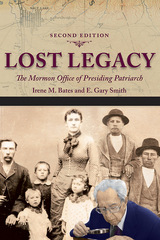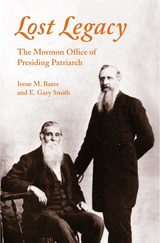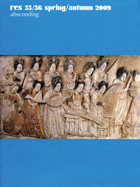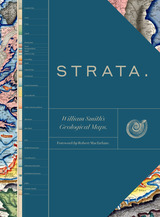4 books about Smith, William

Lost Legacy
The Mormon Office of Presiding Patriarch
Irene M. Bates
University of Illinois Press, 2018
Joseph Smith's father, Joseph Smith Sr., first occupied the hereditary office of Presiding Patriarch of the Church of Jesus Christ of Latter-day Saints. Thereafter, it became a focal point for struggle between those appointed and those born to leadership positions. This new edition of Lost Legacy updates the award-winning history of the office. Irene M. Bates and E. Gary Smith chronicle the ongoing tensions around the existence of a Presiding Patriarch as a source of conflict between the Smith family and the rest of the leadership. Their narrative continues through the dawning realization that familial authority was incompatible with the LDS's structured leadership and the decision to abolish the office of Patriarch in 1979. This second edition, revised and supplemented by author E. Gary Smith, includes a new chapter on Eldred G. Smith, the General Authority Emeritus who was the final Presiding Patriarch. It also corrects the text and provides a new preface by E. Gary Smith.
[more]

Lost Legacy
THE MORMON OFFICE OF PRESIDING PATRIARCH
Irene Bates and E. Gary Smith
University of Illinois Press, 1996

Res
Anthropology and Aesthetics, 55/56: Absconding
Francesco Pellizzi
Harvard University Press, 2009
This volume includes the editorial “The absconded subject of Pop,” by Thomas Crow; “Enlivening the soul in Chinese tombs,” by Wu Hung; “On the ‘true body’ of Huineng,” by Michele Matteini; “Apparition painting,” by Yukio Lippit; “Immanence out of sight,” by Joyce Cheng; “Absconding in plain sight,” by Roberta Bonetti; “Ancient Maya sculptures of Tikal, seen and unseen,” by Megan E. O’Neil; “Style and substance, or why the Cacaxtla paintings were buried,” by Claudia Brittenham; “The Parthenon frieze,” by Clemente Marconi; “Roma sotterranea and the biogenesis of New Jerusalem,” by Irina Oryshkevich; “Out of sight, yet still in place,” by Minou Schraven; “Behind closed doors,” by Melissa R. Katz; “Moving eyes,” by Bissera V. Pentcheva; “‘A secret kind of charm not to be expressed or discerned,’” by Rebecca Zorach; “Ivory towers,” by Richard Taws; “Boxed in,” by Miranda Lash; “A concrete experience of nothing,” by William S. Smith; “Believing in art,” by Irene V. Small; “Repositories of the unconditional,” by Gabriele Guercio; “From micro/macrocosm to the aesthetics of ruins and waste-bodies,” by Jeanette Zwingenberger; “Are shadows transparent?” by Roberto Casati; “Invisibility of the digital,” by Boris Groys; “Des formes et des catégories,” by Remo Guidieri; and “Further comments on ‘Absconding,’” by Francesco Pellizzi.
[more]

Strata
William Smith’s Geological Maps
Edited by the Oxford University Museum of Natural History
University of Chicago Press, 2020
Lavishly illustrated with full-color geological maps, tables of strata, geological cross-sections, photographs, and fossil illustrations from the archives of the Oxford University Museum of Natural History, the Geological Society, the London Natural History Museum, and others, Strata provides the first complete presentation of the revolutionary work of nineteenth-century geologist William Smith, the so-called father of English geology. It illustrates the story of his career, from apprentice to surveyor for hire and fossil collector, from his 1799 geological map of Bath and table of strata to his groundbreaking 1815 geological strata map, and from his imprisonment for debt to his detailed stratigraphical county maps.
This sumptuous volume begins with an introduction by Douglas Palmer that places Smith’s work in the context of earlier, concurrent, and subsequent ideas regarding the structure and natural processes of the earth, geographical mapping, and biostratigraphical theories. The book is then organized into four parts, each beginning with four sheets from Smith’s hand-colored, 1815 strata map, accompanied by related geological cross-sections and county maps, and followed by fossil illustrations by Smith contemporary James Sowerby, all organized by strata. Essays between each section explore the aims of Smith’s work and its application in the fields of mining, agriculture, cartography and hydrology. Strata concludes with reflections on Smith’s later years as an itinerant geologist and surveyor, plagiarism by a rival, receipt of the first Wollaston Medal in recognition of his achievements, and the influence of his geological mapping and biostratigraphical theories on the sciences—all of which culminated in the establishment of the modern geological timescale.
Featuring a foreword by Robert Macfarlane, Strata is a glorious testament to the lasting geological and illustrative genius of William Smith, a collection as colossal and awe-inspiring as the layers of the Earth themselves.
This sumptuous volume begins with an introduction by Douglas Palmer that places Smith’s work in the context of earlier, concurrent, and subsequent ideas regarding the structure and natural processes of the earth, geographical mapping, and biostratigraphical theories. The book is then organized into four parts, each beginning with four sheets from Smith’s hand-colored, 1815 strata map, accompanied by related geological cross-sections and county maps, and followed by fossil illustrations by Smith contemporary James Sowerby, all organized by strata. Essays between each section explore the aims of Smith’s work and its application in the fields of mining, agriculture, cartography and hydrology. Strata concludes with reflections on Smith’s later years as an itinerant geologist and surveyor, plagiarism by a rival, receipt of the first Wollaston Medal in recognition of his achievements, and the influence of his geological mapping and biostratigraphical theories on the sciences—all of which culminated in the establishment of the modern geological timescale.
Featuring a foreword by Robert Macfarlane, Strata is a glorious testament to the lasting geological and illustrative genius of William Smith, a collection as colossal and awe-inspiring as the layers of the Earth themselves.
[more]
READERS
Browse our collection.
PUBLISHERS
See BiblioVault's publisher services.
STUDENT SERVICES
Files for college accessibility offices.
UChicago Accessibility Resources
home | accessibility | search | about | contact us
BiblioVault ® 2001 - 2024
The University of Chicago Press









